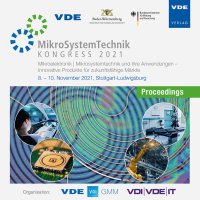Large deflection of electrostatically actuated microbeams – How do the bending modes contribute beyond pull-in?
Conference: MikroSystemTechnik Kongress 2021 - Kongress
11/08/2021 - 11/10/2021 at Stuttgart-Ludwigsburg, Deutschland
Proceedings: MikroSystemTechnik Kongress 2021
Pages: 4Language: englishTyp: PDF
Authors:
Melnikov, Anton; Monsalve, Jorge M.; Wall, Franziska; Mrosk, Andreas; Langa, Sergiu; Gaudet, Matthieu; Kaiser, Bert (Fraunhofer Institute for Photonic Microsystems IPMS, Dresden, Germany)
Schenk, Hermann A. G. (Arioso Systems GmbH, Dresden, Germany)
Stolz, Michael; Schuffenhauer, David (Fraunhofer Institute for Photonic Microsystems IPMS, Dresden, Germany & Brandenburg University of Technology Cottbus-Senftenberg, Cottbus, Germany)
Abstract:
Coulomb-actuated microbeams are widely used in micro-electro-mechanical systems. Current technological trends, such as 5G Internet of Things (5G-IoT), augmented reality, and Green ICT (information and communications technology), drive system level modelling, which requires accurate and efficient lumped parameter models (LPM) of single electro-mechanical components (e.g. MEMS sensors). However, since electro-mechanical systems are highly nonlinear in nature, the development of accurate models is challenging. For actuated beams, a state of the art analytical technique is to expand the beam deflection in terms of suitably chosen eigenfunctions. The targeted LPMs are then obtained by projecting the governing differential equations onto the low dimensional subspace spanned by those eigenmodes (Galerkin projection), deemed relevant. LPMs obtained this way, are hitherto often computationally expensive because, they typically require several degrees of freedom in order to achieve the desired accuracy at larger deflections. The work presented here solves this issue for prismatic Coulomb activated Euler-Bernoulli beams, clamped at both ends. The actual contributions of the leading Euler-Bernoulli eigenmodes to the deflection profiles are investigated, numerically and experimentally. We find that the lowest Euler-Bernoulli mode by far dominates the physics of these devices (zero-mode hypothesis). The finding holds beyond the pull-in, up to a small vicinity of the contact singularity. As a result we are able to develop a new LPM, substantially improving the state of the art, with respect to accuracy and computational simplicity. This paper is a synopsis of Refs.


